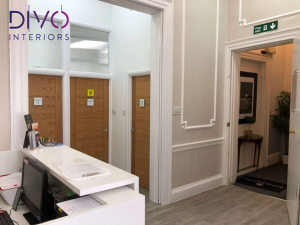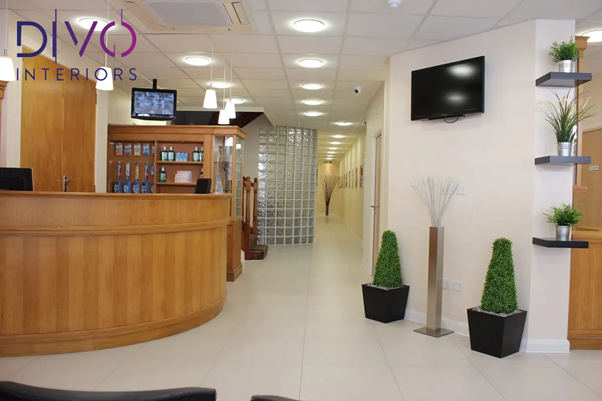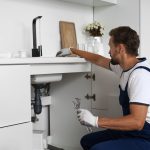Discover the latest trends in dental surgery design, including biophilic design, ergonomic furniture, and advanced imaging for modern dental fitouts.
The dental industry is witnessing a significant transformation, driven by advancements in technology and a renewed focus on patient experience.
Dental surgery design is evolving to meet these demands, incorporating innovative trends that enhance both functionality and aesthetics. Here are seven cutting-edge trends that are reshaping dental practices today.
1. Biophilic Design
Biophilic design is transforming dental surgeries by integrating natural elements to create a soothing and welcoming environment. This design philosophy draws inspiration from nature, aiming to enhance patient well-being and comfort.
By incorporating elements such as plants, natural light, and organic materials, dental practices can reduce patient anxiety and create a more pleasant atmosphere.
- Natural Light: Maximising the use of natural light not only reduces energy consumption but also creates a bright, airy space that can positively impact patient mood and reduce stress. Large windows, skylights, and light wells are popular features in biophilic design.
- Indoor Plants: Incorporating greenery into the dental clinic can improve air quality and add a touch of nature to the environment. Plants like ferns, peace lilies, and succulents are low-maintenance options that thrive indoors.
- Natural Materials: Using materials like wood, stone, and bamboo can add warmth and texture to the clinic’s interior. These materials are not only aesthetically pleasing but also environmentally friendly, supporting the practice’s sustainability goals.
- Water Features: Small water features, such as fountains or aquariums, can create a calming ambiance, helping to relax patients as they wait for their appointments.
By adopting biophilic design principles, dental practices can create a serene and inviting environment that enhances the overall patient experience.
2. Digital Workflow Integration
The integration of digital workflows in dental practices is a game-changer, offering enhanced precision, efficiency, and patient care. By leveraging advanced technologies, dental clinics can streamline their operations and provide superior services.
- CAD/CAM Systems: Computer-Aided Design and Computer-Aided Manufacturing (CAD/CAM) systems enable the precise fabrication of dental restorations such as crowns, bridges, and veneers. These systems reduce turnaround times and improve the accuracy of dental prosthetics.
- Digital Impressions: Traditional dental impressions can be uncomfortable for patients and prone to inaccuracies. Digital impression systems use intraoral scanners to capture detailed images of the teeth and gums, resulting in more accurate and comfortable impressions.
- 3D Printing: 3D printing technology allows for the rapid production of dental models, surgical guides, and custom prosthetics. This technology reduces production costs and time, enabling dentists to provide faster and more personalised care.
- Practice Management Software: Comprehensive software solutions can manage patient records, appointment scheduling, billing, and communication. These systems improve administrative efficiency and enhance the patient experience by reducing wait times and streamlining processes.
By embracing digital workflow integration, dental practices can position themselves at the forefront of innovation, attracting tech-savvy patients and improving their SEO for dentists by highlighting their state-of-the-art services.
3. Ergonomic and Patient-Friendly Furniture
Ergonomic and patient-friendly furniture is essential for creating a comfortable and efficient dental practice. Investing in high-quality, well-designed furniture can significantly enhance the patient experience and support the well-being of dental staff.
- Patient Chairs: Modern patient chairs are designed with ergonomics in mind, featuring memory foam padding, adjustable headrests, and lumbar support. These chairs ensure that patients remain comfortable during procedures, reducing anxiety and discomfort.
- Dental Stools: Ergonomically designed stools for dental professionals are crucial for maintaining proper posture and preventing musculoskeletal issues. Features such as adjustable height, lumbar support, and flexible seating positions help reduce strain during long procedures.
- Reception Area Furniture: The reception area is the first point of contact for patients, and comfortable, stylish furniture can set a positive tone. Sofas and chairs with ergonomic designs, complemented by side tables and magazine racks, create a welcoming atmosphere.
- Workstations: Ergonomic workstations for dental staff, including height-adjustable desks and chairs, promote a healthy work environment. These workstations can help reduce fatigue and increase productivity by providing a comfortable and functional space for administrative tasks.

4. Infection Control and Sterilisation Zones
Infection control is a cornerstone of modern dental practice, and the design of sterilisation zones is crucial in maintaining high standards of hygiene. Dedicated areas equipped with state-of-the-art sterilisation technology ensure that all instruments are properly sanitised, protecting both patients and staff.
- Dedicated Sterilisation Rooms: Segregated from clinical areas, these rooms house autoclaves, ultrasonic cleaners, and other sterilisation equipment. This separation minimises the risk of cross-contamination and ensures a sterile environment.
- Instrument Management Systems: Advanced systems track the sterilisation process of each instrument, ensuring compliance with hygiene protocols. These systems often include barcode scanning and digital record-keeping, providing an audit trail for infection control procedures.
- Sterilisation Workflows: Effective workflows are essential for maintaining hygiene standards. Clearly defined procedures for instrument cleaning, packaging, and storage ensure that every item is properly sterilised and ready for use.
- Visible Hygiene Practices: Showcasing sterilisation zones within the clinic can reassure patients of the practice’s commitment to hygiene. Transparent glass partitions or open-concept designs allow patients to see the sterilisation process, enhancing trust and confidence.
By prioritising infection control through well-designed sterilisation zones, dental practices can ensure a safe environment, reduce the risk of infections, and enhance patient trust.
5. Personalised Patient Experience
Creating a personalised patient experience is a key trend in dental fitous and practice design. Tailoring the environment and services to individual patient needs can significantly enhance satisfaction and loyalty, making each visit unique and memorable.
- Customised Treatment Plans: Personalised treatment plans that consider a patient’s medical history, preferences, and specific needs can improve outcomes and patient satisfaction. This bespoke approach ensures that each patient receives the most appropriate care.
- Personalised Waiting Areas: Waiting areas equipped with amenities like beverage stations, Wi-Fi, tablets for entertainment, and comfortable seating create a relaxing environment. Offering personalised touches, such as preferred reading materials or music playlists, can make patients feel valued.
- Patient Communication: Using digital tools to send appointment reminders, post-treatment care instructions, and follow-up messages can enhance the patient experience. Personalised communication demonstrates a practice’s commitment to patient care and helps build strong relationships.
- Feedback and Improvement: Actively seeking patient feedback and making improvements based on their suggestions can further personalise the patient experience. This approach shows that the practice values patient opinions and is dedicated to continuous improvement.
Personalising the patient experience through dental fitouts can lead to higher patient satisfaction and loyalty, setting a practice apart in a competitive market.
6. Sustainable and Eco-Friendly Materials
Sustainability is an increasingly important consideration in dental practice design. Using eco-friendly materials and incorporating energy-efficient systems not only reduces environmental impact but also appeals to eco-conscious patients.
- Sustainable Building Materials: Using materials such as bamboo, recycled glass, and low-VOC paints helps reduce the environmental footprint. These materials are not only eco-friendly but also durable and aesthetically pleasing.
- Energy-Efficient Systems: Implementing energy-efficient lighting, heating, and cooling systems can significantly reduce energy consumption. LED lighting, solar panels, and programmable thermostats are effective ways to improve energy efficiency.
- Water Conservation: Low-flow plumbing fixtures, water-saving dental equipment, and efficient irrigation systems help conserve water. These features are essential for reducing the overall water usage of a dental practice.
- Waste Reduction: Practices can reduce waste by implementing recycling programs, using biodegradable disposables, and minimising single-use plastics. These initiatives not only benefit the environment but also resonate with environmentally conscious patients.
Adopting sustainable and eco-friendly practices can enhance a dental practice’s reputation, attract like-minded patients, and contribute positively to the environment.
7. Advanced Imaging and Diagnostic Technology
Advanced imaging and diagnostic technologies are transforming dental care, providing more accurate diagnoses and improving treatment outcomes. These innovations enhance the precision and efficiency of dental procedures, making them indispensable in modern practice.
- Intraoral Cameras: High-resolution intraoral cameras allow dentists to capture detailed images of the mouth, helping in accurate diagnosis and treatment planning. These images can be displayed on monitors, enabling patients to see and understand their dental issues.
- 3D Cone Beam CT Scanners: These scanners provide three-dimensional images of dental structures, soft tissues, and bone. This comprehensive view aids in precise diagnosis and is invaluable for complex procedures such as implant placement and orthodontics.
- Digital X-Rays: Digital radiography offers numerous advantages over traditional film X-rays, including lower radiation exposure, immediate image availability, and enhanced image quality. These benefits improve patient safety and diagnostic accuracy.
- CAD/CAM Technology: Computer-Aided Design and Computer-Aided Manufacturing systems enable the precise creation of dental restorations. This technology reduces turnaround times and improves the fit and function of prosthetics.
Integrating advanced imaging and diagnostic technologies into a dental practice not only enhances patient care but also showcases the practice’s commitment to innovation.
Wrapping Up
The dental industry is continuously evolving, with new dental surgery design trends emerging to meet the changing needs of patients and practitioners.
By embracing biophilic design, integrating digital workflows, prioritising ergonomic furniture, ensuring stringent infection control, personalising patient experiences, using sustainable materials, and adopting advanced imaging technologies, dental practices can create a modern, efficient, and welcoming environment.
These not only enhance patient satisfaction but also provide a competitive edge in the market.
Author Bio:
UV Jadeja, the head honcho at Divo Interiors Ltd in London, has spent a significant number of years in the commercial fit-out and refurbishment industry, specialising in dental practices.
Under his leadership, the company has designed and renovated clinics of some of the most well-known dental practices in the country.
He often shares his insights & extensive industry knowledge with the general public through engaging blog posts.







